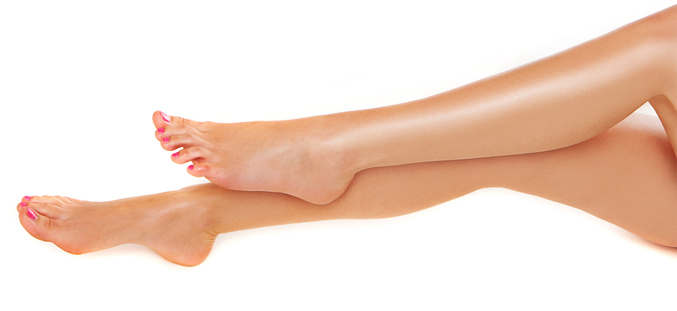If summer comes with shuddering fears of getting your legs out because of varicose veins, you’re not alone. About a third of the UK population are affected and three-quarters of people defer having treatment for their veins because they think surgery is the only option.
But last month, the National Institute for Health and Care Excellence (NICE) published new guidelines making it possible to have your veins treated using low-downtime, non-surgical techniques that can get rid of them permanently.

In the past GPs would recommend patients wear support stockings for six months to see if the problem got better but the new NICE guidelines, released on July 24, 2013 state that if the veins are causing you a problem, you should be referred to a vascular clinic immediately.
It’s been proven that stockings don’t work for varicose veins. This is something that is only used by doctors and insurance companies to put off people having curative treatments, so their problem often gets worse.
Varicose veings often grow back after treatments such as surgical stripping which is risky and painful. There are now safer, more effective treatments that come with less recovery time and thanks to the new NICE guidelines these treatments are now available to many more people. Here are the options
Duplex ultrasound scanning for veins This is an ultrasound scan varicose vein patients have to have to confirm their diagnosis. It is perfectly safe and uses no radiation or needles. For varicose veins, it is performed with the patient standing up and the performing the scan squeezing the leg with one hand and watching the blood flow in the veins with an ultrasound probe in the other hand.
Laser Treatment Also called Endovenous Laser Ablation (EVLA), a catheter, which is a fibre attached to the laser is inserted into the vein under ultrasound control. Essentially the heat generated from the laser seals the vein from the inside. The body dispels the rest of the vein tissue naturally, so it eventually shrinks and disappears. Visible veins need additional treatment on top of this. Success rates in experienced hands should be well over 95 per cent and the results in the treated vein should be permanent. Best for: Medium and large veins seen on ultrasound deep under the skin – not for the veins you can see bulging on the surface which need further treatment after endovenous laser ablation. Risks: Mild tenderness in the thigh area or a pulling sensation is uncommon but if it happens, it can last anywhere up to a few weeks. Downtime: Patients return to work immediately, though chances are they will have bruising lasting a few weeks. Patients are advised to return to their normal mobility immediately. They don’t need to do additional walking, but also must not treat themselves as if they have had major surgery and rest excessively.
Radio-Frequency Ablation Works on the same principle (again, under local anaesthetic with only one tiny incision) as laser treatment, but a different energy is used (a bit like cooking with electricity or gas) to heat up the inside of the vein. The latest version, called Venefit, is a catheter put inside the vein which gets hot because of radiofrequency current passed into the end of it to remove the vein. However there are many patients with complex veins who cannot be treated with this technique. There are other newer radiofrequency ablation techniques available that pass radiofrequency energy into the vein wall, forcing the vein wall to heat itself. These techniques are fast in comparison to the old surgical stripping method. Success rates in experienced hands should be well over 95 per cent and the results in the treated vein should be permanent. Best for: Medium-sized veins and not for the veins you can see bulging on the surface, which need further treatment after radiofrequency ablation. It’s not good for very big veins either. Risks: Mild tenderness only in the thigh area or a pulling sensation is uncommon but if it happens it usually lasts a week or so. Serious but very rare risks include infection and skin burn if the vein is very close to the skin or if the patient is under general anaesthetic or sedation. However if performed under local anaesthetic, the patient is able to say ‘ow’ and so skin burns are unusual. Downtime: Little or none. Patients return to work after the procedure.
Ultrasound-Guided Foam Sclerotherapy In the past, doctors tended to treat small to medium sized veins with sclerotherapy, where a soap-like liquid was injected into the veins to neutralize them and help them disappear. But though this worked on spider veins, success on varicose veins was poor at just 60 per cent. Now foam is injected instead and requires just a fifth of the previous dose and has upped success rates to 75 per cent after one treatment and 85 per cent after more than one treatment. You lie on a couch with your leg raised and the foaming agent is injected into the vein under ultrasound control, which kills off the cells of the vein wall, causing it to shrivel up and die. It requires no anaesthetic and takes between 10 and 30 minutes. Best for: Medium to small veins and often useful after laser or radiofrequency ablation has been used for the deep larger veins. It is virtually the only method that is successful for complex varicose veins particularly those that have come back after previous stripping surgery. Risks: There’s a small risk of allergic reaction to the foam. The treated area of skin can also darken but this usually fades within a few months. There is an exceptionally small risk of migraine and incredibly rarely stroke. Downtime: patients return to work after the procedure, but it does require firm compression with stockings for two weeks afterwards, unlike the other two procedures. Sometimes, more than one treatment is required.
Stripping or Tying and Stripping of Varicose Veins Used to be performed under a general anaesthetic. A cut in the groin or behind the knee exposes the vein. The surgeon ties the vein at the junction with the deep system and passes a wire down the vein and out through the skin, stripping the vein out of the leg. Although the traditional operation for many years, it has not been used by up-to-date vein experts since 2000. Research has shown it is not only painful and bruising, it also allows the vein to grow back again.
Phlebectomy literally the ‘removal of a vein’. Often used in conjunction with endovenous laser ablation or radiofrequency ablation, phlebectomy is the removal of bulging veins on the surface. It’s performed under local anaesthetic using a fine blade making a tiny hole, and the vein is removed with tiny hooks. Gives a good cosmetic result for the bulging veins without the risk of brown stains that foam sclerotherapy can require and only requires compression for one hour post operatively. Best for: Bulging veins on the surface. This is rarely a treatment done by itself and often needs to be in conjunction with treatment of underlying veins. Downtime: There should be no downtime and patients can return to work immediately after the procedure wearing a support stocking.
Support stockings Since the NICE guidelines of 24th of July 2013 support stockings should never be used to treat varicose veins that can be treated. Support stockings should only be prescribed to patients who are unable to have treatment though they can be used post treatment to help healing.
If none of the treatments here apply to you, some specialist treatments often performed only by specialist veins clinics are also available
Perforator vein closure (TRLOP-transluminal occlusion of perforators) There are a great many smaller veins called perforating veins that the treatments above may not be able to treat. In 2001, TRLOP (transluminal occlusion of perforators) was invented which allowed these perforating veins to be closed with a single needle hole under ultrasound control using either laser or a special radiofrequency probe. Best for: Only useful for these perforating veins Downtime: patients can return to work immediately after treatment wearing a support stocking.
Pelvic vein embolisation (PVE) One in five women who have had children and who have varicose veins actually have a major contribution to their varicose veins from their pelvic veins. Once diagnosed, treatment is by the insertion of coils into these veins under x-ray control, using a pinhole access in a vein in the neck. Although this sounds a strange entry point, it is the best route to get successful access to the pelvic veins which all point upwards. Research shows that when performed in a specialist clinic that has years of experience, the results are excellent and long-lasting. Best for: pelvic veins only. Downtime: Often performed under sedation and so the patient is able to resume full normal activity the day following treatment.
New treatments to watch out for
Venaseal glue (cyanoacrylate or “superglue”) inserted into the leg vein via a long tube under ultrasound control just like endovenous laser ablation or radiofrequency ablation, glue has the advantage of not using heat and therefore not needing local anaesthetic injections along the course of the vein. One vein can be treated with only one local anaesthetic injection. Early results look promising. The biggest drawback is cost. Being a new product, it is considerably more expensive than endovenous laser ablation and radiofrequency ablation. Best for Medium and large veins seen on ultrasound deep under the skin. Not for the veins you can see bulging on the surface Downtime there is no downtime and the patient can return to work immediately wearing only a support stocking.
Clarivein (MOCA – mechanicochemical ablation): as with the Venaseal glue, Clarivein is one of the new techniques to try to close the large veins that underlie and cause varicose veins without using heat and therefore not needing injections of local anaesthetic. Clarivein works by having a rotating wire that scratches the inside of the vein whilst sclerotherapy solution is dribbled into the vein, penetrating the wall and destroying it. Best for medium-sized deeper veins that underlie the bulging varicose veins. Not for large veins or for the bulging veins on the surface. Downtime no downtime and the patient is able to return to work immediately wearing a support stocking.
Professor Whitely practices at The Whiteley Clinics in London and Guildford
Like this article? Sign up to our newsletter to get more articles like this delivered straight to your inbox.





















































